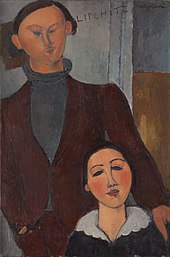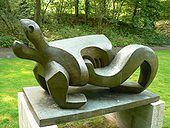Jacques Lipchitz
Jacques Lipchitz , actually Chaim Lipschitz Jakoff , (born August 10 . Jul / 22. August 1891 greg. In Druskininkai , Russian Empire , now Lithuania , † 16th May 1973 on Capri ) was a French- American sculptor of the 20th century .
Life
After graduating from commercial school, Lipchitz moved to Paris in 1909 with the help of his mother , where he studied at the École nationale supérieure des beaux-arts and the Académie Julian . In Paris he met Georges Braque , Juan Gris and Pablo Picasso . From 1912 he exhibited regularly at the Salon d'Automne and the Salon National des Beaux-Arts. In 1915 he met Berthe Kitrosser, whom he later married. He obtained French citizenship in 1924 and moved to Boulogne-sur-Seine the following year .
Among the emigrants who managed to escape from the Vichy regime in France in 1941 were intellectuals and artists, for example, alongside Lipchitz, who was of Jewish descent, Marc Chagall and Max Ernst . The escape was made possible by the American journalist Varian Fry , who headed an aid committee in Marseille , the Emergency Rescue Committee , to enable refugees to leave the country. Lipchitz settled in New York and rented a studio at 2 East 23rd Street .
In 1946 a stay of several months in Paris followed; his wife Berthe decided to stay there, and the divorce ensued. In 1948, Lipchitz worked with architect Philip Johnson on the roofless church in New Harmony , Indiana . He designed one of the gates of the church that lead into the nave. In the same year he received American citizenship and married his second wife, the sculptor Yulla Halberstadt; his only child, Lolya Rachel, was born. In 1949 Lipchitz moved to Hastings-on-Hudson , New York . In 1960 he was elected to the American Academy of Arts and Sciences and in 1961 to the American Academy of Arts and Letters . Lipchitz visited Israel for the first time in 1963 and from 1964 to 1966 was represented annually in exhibitions at the Marlbourough-Gerson Gallery in New York. In 1973 he was accepted as an external member of the Académie des Beaux-Arts .
Lipchitz died on Capri in 1973 and was buried in Jerusalem .
plant
In 1913, influenced by Pablo Picasso and his friendship with the Mexican artist Diego Rivera , he created his first cubist works, which he still designed from the front . In 1915 he succeeded in creating the simultaneity of the views, the all-round opening towards the space and the new structure from independent complexes of forms.
In 1919 his style changed, the works contained greater unrest or zigzag lines. In the 1920s, Lipchitz approached organic, softly curved shapes that are reminiscent of idol-like monuments and evolve into moving baroque structures.
In 1952 Jacques Lipchitz took part in the 26th Venice Biennale and documenta II (1959) and documenta III in 1964 in Kassel .
Exhibitions
- 1920: Galerie l'Effort Moderne, Paris (solo exhibition)
- 1930: Galerie de la Renaissance, Paris (retrospective)
- 1935: Brummer Gallery , New York
- 2014: Jacques Lipchitz. Drawings 1910-1972. A gift from the estate. , Pinakothek der Moderne , Munich
- 2014: Jacques Lipchitz Retrospettiva, Casa Rusca Locarno, Switzerland
- 2016: Life in Sculpture. Jacques Lipchitz, Vilna Gaon Jewish State Museum, Vilnius
- 2017: Jacques Lipchitz. Seven sculptures and works on paper 1915–1968. Donated by the Jacques and Yulla Lipchitz Foundation. Museum Kunstpalast, Düsseldorf
Works
- 1916: Personnage debout (standing figure) , limestone, 108 × 23.2 × 20.3 cm, Solomon R. Guggenheim Museum , New York
- 1917–18: Marin à la guitar (sailor with guitar) , limestone, 90 × 382 × 34 cm, Center Georges Pompidou , Musée National d'Art Moderne , Paris
- 1933: David and Goliath (sculpture), Museum Kunstpalast , Düsseldorf
literature
- Henry R. Hope: The sculpture of Jacques Lipchitz , MOMA, New York 1954
- Thomas Krens (preface): Rendezvous. Masterpieces from the Center Georges Pompidou and the Guggenheim Museums . Guggenheim Museum Publications, New York 1998, ISBN 978-0810969162
- Michael Parke-Taylor: Jacques Lipchitz, mother with child , Norman Mackenzie Art Gallery, Regina, Sask. 1983, ISBN 0-920922-17-1
Web links
- Literature by and about Jacques Lipchitz in the catalog of the German National Library
- artdirectory: short biography
- kunstaspekte.de via Lipchitz
- marlboroughgallery.com about Lipchitz (English)
- artcyclopedia.com about Lipchitz (English)
- Entry in Encyclopædia Britannica (English)
- Materials by and about Jacques Lipchitz in the documenta archive
Individual evidence
- ^ Mary V. Dearborn: I have no regrets !: The extraordinary life of Peggy Guggenheim . Bastei Lübbe, Bergisch Gladbach 2007, ISBN 978-3-404-61615-2 , p. 10
- ^ Members: Jacques Lipchitz. American Academy of Arts and Letters, accessed April 10, 2019 .
- ↑ Quoted from marlboroughgallery.com
- ^ Announcement on the exhibition , accessed on November 17, 2014.
- ↑ Presentation of the donation from the Jacques and Yulla Lipchitz Foundation: a group of seven sculptures and 21 works on paper from the years 1915–1968. From Thursday, February 16, 2017
| personal data | |
|---|---|
| SURNAME | Lipchitz, Jacques |
| ALTERNATIVE NAMES | Lipschitz, Chaim Jakoff (maiden name) |
| BRIEF DESCRIPTION | Lithuanian-French-American sculptor |
| DATE OF BIRTH | August 22, 1891 |
| PLACE OF BIRTH | Druskininkai , Russian Empire , today Lithuania |
| DATE OF DEATH | May 16, 1973 |
| Place of death | Capri , Italy |

